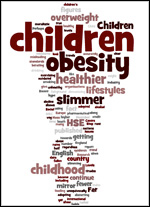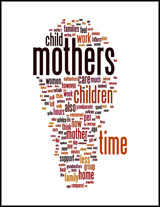Mirror, mirror
A summary of research findings on body image
Motives: why we look in the mirror
We are all more obsessed with our appearance than we like to admit. But this is not an indication of 'vanity'. Vanity means conceit, excessive pride in one's appearance. Concern about appearance is quite normal and understandable. Attractive people have distinct advantages in our society. Studies show:
- Attractive children are more popular, both with classmates and teachers. Teachers give higher evaluations to the work of attractive children and have higher expectations of them (which has been shown to improve performance).
- Attractive applicants have a better chance of getting jobs, and of receiving higher salaries. (one US study found that taller men earned around $600 per inch more than shorter executives.)
- In court, attractive people are found guilty less often. When found guilty, they receive less severe sentences.
- The 'bias for beauty' operates in almost all social situations – all experiments show we react more favourably to physically attractive people.
- We also believe in the 'what is beautiful is good' stereotype – an irrational but deep-seated belief that physically attractive people possess other desirable characteristics such as intelligence, competence, social skills, confidence – even moral virtue. (The good fairy/princess is always beautiful; the wicked stepmother is always ugly)
It is not surprising that physical attractiveness is of overwhelming importance to us.
Concern with appearance is not just an aberration of Modern Western culture. Every period of history has had its own standards of what is and is not beautiful, and every contemporary society has its own distinctive concept of the ideal physical attributes. In the 19th Century being beautiful meant wearing a corset – causing breathing and digestive problems. Now we try to diet and exercise ourselves into the fashionable shape – often with even more serious consequences.
But although we resemble our ancestors and other cultures in our concern about appearance, there is a difference in degree of concern. Advances in technology and in particular the rise of the mass media has caused normal concerns about how we look to become obsessions.
How? 3 reasons:
- Thanks to the media, we have become accustomed to extremely rigid and uniform standards of beauty.
- TV, billboards, magazines etc mean that we see 'beautiful people' all the time, more often than members of our own family, making exceptional good looks seem real, normal and attainable.
- Standards of beauty have in fact become harder and harder to attain, particularly for women. The current media ideal of thinness for women is achievable by less than 5% of the female population.
Even very attractive people may not be looking in the mirror out of 'vanity', but out of insecurity. We forget that there are disadvantages to being attractive: attractive people are under much greater pressure to maintain their appearance. Also, studies show that attractive people don't benefit from the 'bias for beauty' in terms of self-esteem. They often don't trust praise of their work or talents, believing positive evaluations to be influenced by their appearance.
Images and reactions: what we see and how we feel about it
What people see and how they react to their reflection in a mirror will vary according to: species, sex, age, ethnic group, sexual orientation, mood, eating disorders, what they've been watching on TV, what magazines they read, whether they're married or single, what kind of childhood they had, whether they take part in sports, what phase of the menstrual cycle they're in, whether they are pregnant, where they've been shopping – and even what they had for lunch.
Species
If you were a dog or a cat or a horse you wouldn't realise that the image was a reflection of yourself. Most animals in this situation think that they are face to face with another member of their species.
The exception is the great apes – chimps, gorillas and orang-utans are capable of recognising themselves in the mirror – and of course the Naked Apes: us.
What's interesting is what the other apes do when presented with a mirror: they use mirrors to groom themselves, pick food out of their teeth and make faces at themselves for entertainment – i.e. more or less the same reactions as us Naked Apes.
Sex
All research to date on body image shows that women are much more critical of their appearance than men – much less likely to admire what they see in the mirror. Up to 8 out of 10 women will be dissatisfied with their reflection, and more than half may see a distorted image.
Men looking in the mirror are more likely to be either pleased with what they see or indifferent. Research shows that men generally have a much more positive body-image than women – if anything, they may tend to over-estimate their attractiveness. Some men looking in the mirror may literally not see the flaws in their appearance.
Why are women so much more self-critical than men? Because women are judged on their appearance more than men, and standards of female beauty are considerably higher and more inflexible. Women are continually bombarded with images of the 'ideal' face and figure – what Naomi Woolf calls 'The Official Body'. Constant exposure to idealised images of female beauty on TV, magazines and billboards makes exceptional good looks seem normal and anything short of perfection seem abnormal and ugly. It has been estimated that young women now see more images of outstandingly beautiful women in one day than our mothers saw throughout their entire adolescence.
Also, most women are trying to achieve the impossible: standards of female beauty have in fact become progressively more unrealistic during the 20th century. In 1917, the physically perfect woman was about 5ft 4in tall and weighed nearly 10 stone. Even 25 years ago, top models and beauty queens weighed only 8% less than the average woman, now they weigh 23% less. The current media ideal for women is achievable by less than 5% of the female population – and that's just in terms of weight and size. If you want the ideal shape, face etc., it's probably more like 1%.
Age
Children: Female dissatisfaction with appearance – poor body-image – begins at a very early age. Human infants begin to recognise themselves in mirrors at about two years old. Female humans begin to dislike what they see only a few years later. The latest surveys show very young girls are going on diets because they think they are fat and unattractive. In one American survey, 81% of ten-year-old girls had already dieted at least once. A recent Swedish study found that 25% of 7 year old girls had dieted to lose weight – they were already suffering from 'body-image distortion', estimating themselves to be larger than they really were. Similar studies in Japan have found that 41% of elementary school girls (some as young as 6) thought they were too fat. Even normal-weight and underweight girls want to lose weight.
Boys were found to be significantly less critical of their appearance: in one study, normal-weight girls expressed considerably more worries about their looks than obese boys.
Adolescents: Boys do go through a short phase of relative dissatisfaction with their appearance in early adolescence, but the physical changes associated with puberty soon bring them closer to the masculine ideal – i.e. they get taller, broader in the shoulders, more muscular etc.
For girls, however, puberty only makes things worse. The normal physical changes – increase in weight and body fat, particularly on the hips and thighs, take them further from the cultural ideal of unnatural slimness. A Harvard University study showed that up to two thirds of underweight 12-year-old girls considered themselves to be too fat. By 13, at least 50% of girls are significantly unhappy about their appearance. By 14, focused, specific dissatisfactions have intensified, particularly concerning hips and thighs. By 17, only 3 out of 10 girls have not been on a diet – up to 8 out of 10 will be unhappy with what they see in the mirror.
Adults: Among women over 18 looking at themselves in the mirror, research indicates that at least 80% are unhappy with what they see. Many will not even be seeing an accurate reflection. Most of us have heard that anorexics see themselves as larger than they really are, but some recent research indicates that this kind of distorted body-image is by no means confined to those suffering from eating disorders – in some studies up to 80% of women over-estimated their size. Increasing numbers of normal, attractive women, with no weight problems or clinical psychological disorders, look at themselves in the mirror and see ugliness and fat.
Research confirms what most of us already know: that the main focus of dissatisfaction for most women looking in the mirror is the size and shape of their bodies, particularly their hips, waists and thighs.
In the most recent research, there is some evidence of an increase in body-dissatisfaction among males. As well as some early-adolescent boys, men undergoing the so-called 'male menopause' or mid-life crisis – i.e. men between the ages of about 45 and 55 – are most likely to be dissatisfied with their appearance.
When men are dissatisfied, the main focuses of concern are height, stomachs, chests and hair loss. We may see them surreptitiously drawing in their stomachs and walking 'taller' as they pass the mirror.
Ethnic group
There are some exceptions to these rules. Black and Asian women generally have a more positive body-image than Caucasian women, although this depends on the degree to which they have accepted the beauty standards of the dominant culture.
A study of Mexican immigrants in America found that those who had immigrated after the age of 17 were less affected by the prevailing super-thin ideal than those who were 16 or younger when they came to the US. In a Washington University study, Black women with high self-esteem and a strong sense of racial identity actually rated themselves more attractive than pictures of supposedly 'beautiful' white fashion models. In another study about 40% of moderately and severely overweight Black women rated their figures to be attractive or very attractive. Other research indicates that this may be because African-American women are more flexible in their concepts of beauty than their White counterparts, who express rigid ideals and greater dissatisfaction with their own body-shape.
In a study of British and Ugandan students' evaluation of body-shapes, the Ugandans rated an 'obese' female figure much more attractive than the British (they were also more tolerant of too-skinny males). Another British study showed that Asian-British women were more content with their body size than white British women, despite the fact that the Asians' ideal body size was as slim as that of the white women, suggesting that the Asian-British women were less concerned about matching the ideal than the white women.
Sexual orientation
Gay men are more likely than straight men to be unhappy with their reflection in the mirror. But lesbians are likely to be more satisfied with their mirror-image than straight women.
Recent studies show that homosexual men experience greater body-dissatisfaction than heterosexual men, while homosexual women have a more positive body-image than heterosexual women. This seems to be mainly due to the higher emphasis on appearance in gay male culture – although it is possible that stability of relationships (see below) may also be a factor.
TV & Magazines
People's reactions to their reflection in the mirror may depend on recent exposure to idealised images of physical attractiveness. Experiments have shown that people become significantly more dissatisfied with their own appearance after being shown TV ads featuring exceptionally slim and beautiful people. Control groups shown non-appearance-related ads do not change their rating of their own attractiveness.
Although many TV programmes feature attractive people, ads tend to use the most idealised images, so people who've been watching a lot of ITV and C4 are likely to feel less positive about their image in the mirror. Programmes such as 'Baywatch' are also likely to induce a sense of dissatisfaction.
The same applies to reading fashion magazines. Recent experiments have shown that exposure to magazine photographs of super-thin models produces depression, stress, guilt, shame, insecurity, body-dissatisfaction and increased endorsement of the thin-ideal stereotype. Magazines like Vogue and Elle are banned in many eating-disorder clinics, because of their known negative effect on patients' body-image.
Mood
Experiments have shown that when people are feeling low or in a bad mood, they experience greater body-dissatisfaction. Most studies have been on women, who also suffer body-image distortion, estimating their size larger, when feeling low.
Childhood
Teasing factor: If you were teased about flaws in your appearance (particularly your size or weight) as a child or teenager, your body image may have become permanently disturbed.
Touch-deprivation factor: People suffering from extreme body-image disturbance report a lack of holding and hugging as children.
Married or single
Generally, people in stable, long-term relationships (not necessarily marriage – see note on lesbians above) have a more positive body-image than singles. This applies to all ages, although an American study of adolescent 'dating-behaviour' showed that teenagers who 'date' in groups have a significantly better body-image than those go out alone with their boyfriend or girlfriend.
Pregnancy
Several studies have indicated that pregnant women have a more positive body-image than non-pregnant women – although their 'ideal' body shape remains in line with the ultra-thin cultural ideal, their concerns about failing to match this ideal are reduced during pregnancy.
Eating-disorders
Anorexics and bulimics suffer from greater body-dissatisfaction and greater body-image disturbance than other women: these women are even more likely to be unhappy with their reflection in the mirror, and even more likely to see a distorted image.
Lunch
In experiments, women with eating disorders judged their actual body size to have increased after consuming a bar of chocolate and a soft-drink. Eating-disordered women may see an even larger person in the mirror if they have just had a high-calorie lunch or snack.
Shopping
Surveys show that women who have just been trying on clothes (particularly swimsuits) in communal changing rooms of high street stores will be experiencing a higher level of body-dissatisfaction and self-criticism, and are more likely to have a negative reaction to their reflection in the mirror.
Menstrual cycle
Women in the pre-menstrual phase of their cycle experience higher levels of body-dissatisfaction than at other times.
Body Dysmorphic Disorder
also known as Dysmorphophobia and Imagined Ugliness Disorder) People suffering from BDD (an extreme level of body-image disturbance, body-dissatisfaction, self-consciousness and preoccupation with appearance) will experience the most negative reactions to the mirror.
Sport
Perhaps surprisingly, given that their physique is closest to the stereotype masculine ideal, male body-builders experience greater dissatisfaction with their appearance than almost any other males. Body-builders are generally regarded as vain: in fact they suffer from low self-esteem combined with high perfectionism.
One American study indicates that female body-builders, by contrast, seem to have a more positive body-image than other women. A London University study appears to confirm this, finding that women who take part in sport (body-builders, rowers and netballers) have more positive perceptions of their own bodies and increased acceptance of muscular body shapes, despite their divergence from cultural ideals. It is interesting to note that another study showed exercise therapy to be as effective as conventional psychotherapy in treating serious body-image disturbance in young women.
Generally both men and women who participate in sport have a more positive body-image than those who do not.
Obesity
Fat-phobia and prejudice against the overweight in our culture is such that obese people (particularly women) tend to have a very poor body-image – not to mention severe anxiety and depression (studies have shown the mental well-being of obese women to be worse than that of the chronically ill or even severely disabled). These problems are not caused by obesity itself – in cultures without fat-phobia or where fat is admired, obese people show no signs of these effects – but by social pressure and the association of beauty with thinness.
Acceptance of sociocultural standards
Most of us are aware of our society's emphasis on the importance of appearance, and we know what the socially sanctioned standards of beauty are. But not all of us accept or 'internalise' these standards: strong-minded individuals who reject current standards are more likely to have a positive body-image.





